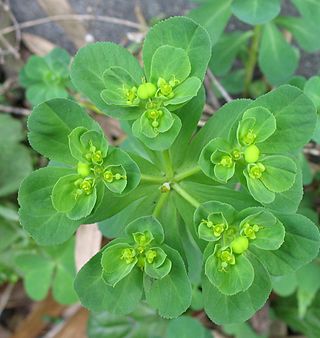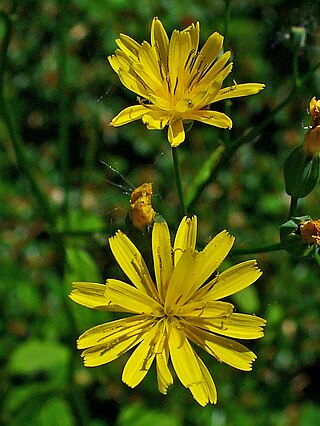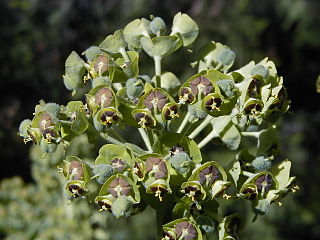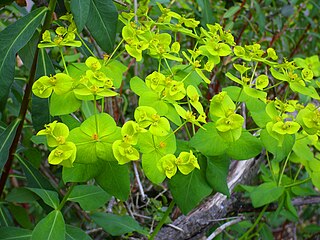
Euphorbia is a very large and diverse genus of flowering plants, commonly called spurge, in the family Euphorbiaceae. "Euphorbia" is sometimes used in ordinary English to collectively refer to all members of Euphorbiaceae, not just to members of the genus.

Aphthona is a genus of beetle, in the leaf beetle family Chrysomelidae, native to Europe and Asia. More specifically, Aphthona are flea beetles, meaning they have enlarged hind legs for jumping away from potential danger. There are some 300 species known worldwide.

Euphorbia helioscopia, the sun spurge or madwoman's milk, is a species of flowering plant in the spurge family Euphorbiaceae. It is a herbaceous annual plant, native to most of Europe, northern Africa, and eastward through most of Asia.

Lapsana communis, the common nipplewort, is a species of flowering plant in the family Asteraceae. It is native to Europe and southwestern Asia, and it is widely naturalized in other regions including North America.

Euphorbia myrsinites, the myrtle spurge, blue spurge, or broad-leaved glaucous-spurge, is a succulent species of flowering plant in the spurge family Euphorbiaceae.

Euphorbia peplus, is a species of Euphorbia, native to most of Europe, northern Africa and western Asia, where it typically grows in cultivated arable land, gardens and other disturbed land.

Hyles euphorbiae, the spurge hawk-moth, is a European moth of the family Sphingidae. It has been found in Pontresina, Switzerland. This hawk moth is used as an agent of biological pest control against the noxious weed leafy spurge, but usually only in conjunction with other agents. The larvae consume the leaves and bracts of the plant. The species was first described by Carl Linnaeus in his 1758 10th edition of Systema Naturae.

Agave shawii is a species of monocarpic succulent plant in the genus Agave, commonly known as Shaw's agave. It is a rosette-forming plant characterized by glossy, green leaves with toothed margins. After several years of slow growth, the plant puts all of its resources to produce a towering stalk of flowers, and then dies. The death of the flowering rosette is compensated by the growth of numerous clonal pups. This species is segregated into two subspecies, one native to the coast of southwestern California and northwestern Baja California, known commonly as the coast agave, and another native to the Baja California desert, known as the Goldman agave.
Leafy spurge may refer to several species of plant in the genus Euphorbia, including:
Aphthona abdominalis is a species of leaf beetle known as the minute spurge flea beetle. It was used as an agent of biological pest control against the noxious weed leafy spurge, but never established a viable population.
Aphthona cyparissiae is a species of leaf beetle known as the brown dot leafy spurge flea beetle. It is used as an agent of biological pest control against the noxious weed leafy spurge.
Aphthona czwalinae is a species of leaf beetle known as the black leafy spurge flea beetle. It is used as an agent of biological pest control against the noxious weed leafy spurge.

Euphorbiaceae, the spurge family, is a large family of flowering plants. In English, they are also commonly called euphorbias, which is also the name of the type genus of the family. Most spurges, such as Euphorbia paralias, are herbs, but some, especially in the tropics, are shrubs or trees, such as Hevea brasiliensis. Some, such as Euphorbia canariensis, are succulent and resemble cacti because of convergent evolution. This family has a cosmopolitan global distribution. The greatest diversity of species is in the tropics; however, the Euphorbiaceae also have many species in nontropical areas of all continents except Antarctica.

Euphorbia paralias, the Sea Spurge, is a species of flowering plant in the family Euphorbiaceae, native to Europe, northern Africa and western Asia.

Euphorbia characias, the Mediterranean spurge or Albanian spurge, is a species of flowering plant in the family Euphorbiaceae typical of the Mediterranean vegetation. It is an upright, compact evergreen shrub growing to 1.2 m tall and wide.

Chamaesphecia crassicornis is a moth of the family Sesiidae. It is found in south-eastern Austria, southern Slovakia, Hungary, Serbia, Romania, Bulgaria, southern Russia, Kazakhstan and Kyrgyzstan. It is rare in central Europe. It has been released in North America for the biological control of leafy spurge.

Euphorbia lamarckii is a species of flowering plant in the family Euphorbiaceae, native to the western Canary Islands. It resembles Euphorbia regis-jubae, with which it has been confused. Both have been called Euphorbia obtusifolia.

Euphorbia regis-jubae is a species of flowering plant in the family Euphorbiaceae, native to the eastern Canary Islands, western Morocco, north-western Western Sahara. In Spanish, it is known as tabaiba morisca. It has often been confused with Euphorbia lamarckii. The specific epithet regis-jubae, meaning 'King Juba's euphorbia' honours the king's contributions to natural history and his role in bringing the genus to notice. The palm tree genus Jubaea is also named after Juba.

Euphorbia virgata, commonly known as leafy spurge, wolf's milk leafy spurge, or wolf's milk is a species of spurge native to Europe and Asia, and introduced in North America, where it is an invasive species.

Euphorbia paniculata is a species of flowering plant in the spurge family Euphorbiaceae, native to the Iberian Peninsula and North Africa in the western Mediterranean Basin.

















